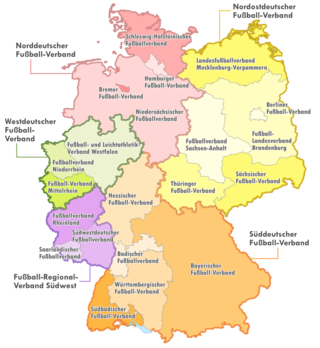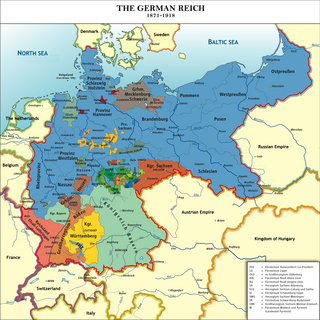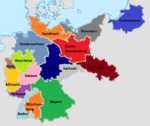
The DDR-Oberliga was the top-level association football league in East Germany.

The Oberliga is the fifth tier of the German football league system. Before the introduction of the 3. Liga in 2008, it was the fourth tier. At the end of the 2011–12 season the number of Oberligas was increased from eleven to fourteen.
The NOFV-Oberliga is a division at step 5 of the German football league system. After the fall of the Berlin Wall, it became the successor of the DDR-Oberliga, and functions today as a 5th division in the former territory of East Germany and the city of Berlin.
VfL Halle 1896 is a German football club from the city of Halle (Saale) in Saxony-Anhalt.

SV Fortuna Magdeburg is a German association football club from the city of Magdeburg in Saxony-Anhalt.
The NOFV-Oberliga Süd is the fifth tier of the German football league system in the southern states of the former East Germany. It covers the German states of Saxony-Anhalt, Thuringia, Saxony and southern Brandenburg. It is one of fourteen Oberligas in German football. Until the introduction of the 3. Liga in 2008 it was the fourth tier of the league system, and until the introduction of the Regionalligas in 1994 the third tier.
The Verbandsliga Sachsen-Anhalt is the sixth tier of the German football league system and the highest league in the German state of Saxony-Anhalt. Until the introduction of the 3. Liga in 2008 it was the fifth tier of the league system, until the introduction of the Regionalligas in 1994 the fourth tier.

The Gauliga Württemberg was the highest football league in the German state of Württemberg and the Prussian province of Hohenzollern from 1933 to 1945. Shortly after the formation of the league, the Nazis reorganised the administrative regions in Germany, and the Gau Württemberg-Hohenzollern replaced the Prussian province and state of Württemberg.

The Gauliga Hessen was the highest football league in the German state of Hesse and the Prussian province of Hesse-Nassau from 1933 to 1945. From 1941, it was renamed Gauliga Kurhessen. Shortly after the formation of the league, the Nazis reorganised the administrative regions in Germany, and the GauElectoral Hesse replaced the Prussian province and the Peoples State.

The Gauliga Berlin-Brandenburg was the highest football league in the provinces of Brandenburg and Berlin in the German state of Prussia from 1933 to 1945. Shortly after the formation of the league, the Nazis reorganised the administrative regions in Germany, and the GaueBrandenburg and Berlin replaced the Prussian provinces.

The Gauliga Ostpreußen was the highest football league in the Prussian province of East Prussia and the Free City of Danzig from 1933 to 1945. Shortly after the formation of the league, the Nazis reorganised the administrative regions in Germany, and the GauEast Prussia the Prussian province. Danzig however did not become part of this Gau, being integrated in the Gau Danzig-West Prussia in 1939 instead.

The Gauliga Pommern was the highest football league in the Prussian province of Pomerania (German:Pommern) from 1933 to 1945. Shortly after the formation of the league, the Nazis reorganised the administrative regions in Germany, and the GauPomerania replaced the province of Pomerania.

The Gauliga Saxony was the highest football league in the German state of Saxony (German:Sachsen) from 1933 to 1945. Shortly after the formation of the league, the Nazis reorganised the administrative regions in Germany, and the Gau Saxony replaced the state Saxony.

The Gauliga Niederrhein was the highest football league in the northern part of the Prussian Rhine Province from 1933 to 1945. Shortly after the formation of the league, the Nazis reorganised the administrative regions in Germany, and the GaueEssen and Düsseldorf replaced the Prussian province in the Lower Rhein region.

The Gauliga Mittelrhein was the highest football league in the central and southern part of the Prussian Rhine Province from 1933 to 1945. Shortly after the formation of the league, the Nazis reorganised the administrative regions in Germany, and the GaueKöln-Aachen and Moselland replaced the Prussian province in the Middle Rhine region.

The Gauliga Niedersachsen was the highest football league in the Prussian Province of Hanover and the German states of Bremen, Brunswick, Schaumburg-Lippe and Oldenburg from 1933 to 1945. Shortly after the formation of the league, the Nazis reorganised the administrative regions in Germany, and the GaueSüdhannover-Braunschweig, Ost-Hannover and Weser-Ems de facto replaced the Prussian province and the German states in the region of Lower Saxony (German:Niedersachsen), although de jure the old states continued to exist.

The Gauliga Nordmark was the highest football league in the Prussian Province of Schleswig-Holstein and the German states of Hamburg, Lübeck, Mecklenburg-Schwerin, Mecklenburg-Strelitz and parts of Oldenburg from 1933 to 1945. Shortly after the formation of the league, the Nazis reorganised the administrative regions in Germany, and the GaueHamburg, Mecklenburg and Schleswig-Holstein replaced the Prussian province and the German states in this northern region of Germany.

The Gauliga Schlesien was the highest football league in the region of Silesia (German:Schlesien), which consisted of the Prussian provinces of Lower Silesia and Upper Silesia from 1933 to 1945. Shortly after the formation of the league, the Nazis reorganised the administrative regions in Germany, and the Gau Silesia, later subdivided into Gau Upper Silesia and Gau Lower Silesia, replaced the Prussian provinces.

The Central German football championship was the highest association football competition in Central Germany, in what is now the federal states of Saxony, Saxony-Anhalt and Thuringia, established in 1902. The competition was disbanded in 1933 with the rise of the Nazis to power.

SV Merseburg 99 is a sports club from Merseburg in Saxony-Anhalt. The club has existed since August 23, 1899. The club colors are green and white. The club's home base is the Merseburg City Stadium.






